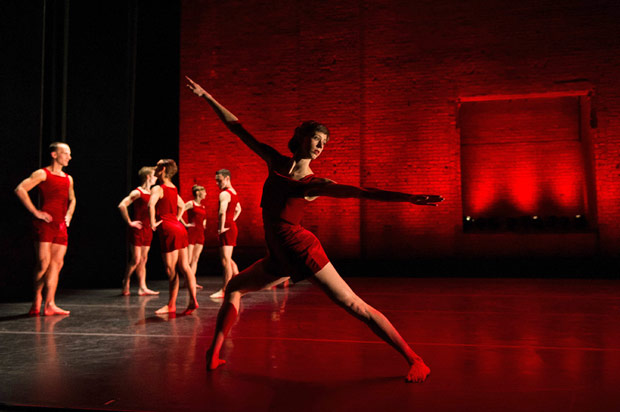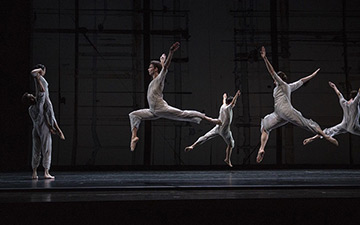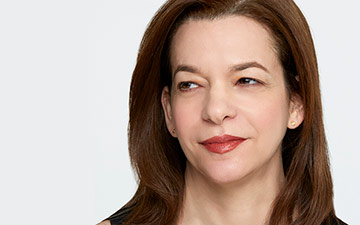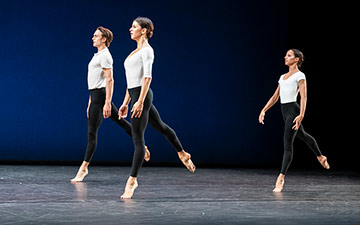
© Christopher Duggan. (Click image for larger version)
Pam Tanowitz Dance
the story progresses as if in a dream of glittering surfaces, Heaven on One’s Head
★★★✰✰
New York, Joyce Theater
18 February 2016
pamtanowitzdance.org
www.joyce.org
There are choreographers who make one go hot and cold, and one of those, for me, is Pam Tanowitz. There is no doubting the intelligence of her approach, the cleverness with which she combines steps, the intensity of her curiosity about movement. She has wit, and, out of nowhere it seems, manages to create moments of surprising mystery. But some of her dances have a way of not adding up, of resisting sustained attention. Instead they’re made up of modules, particles drawn mostly from the vocabularies of ballet and Merce Cunningham. Often, these modules are interesting in and of themselves, but they remain disconnected, like a series of curious and highly complicated exercises.
Her current run at the Joyce consists of two works, Heaven on One’s Head, from 2014, and the new the Story Progresses as if in a Dream of Glittering Surfaces. I’ve reviewed Heaven on One’s Head before, and, on second viewing it still holds up. It’s one of Tanowitz’s more playful dances, set to Conlon Nancarrow’s first and third quartets, performed live by the FLUX Quartet. Both the music and the dance are extremely lively. There’s a section during which the curtain is lowered almost all the way to the floor, so that all we see of the dancers is their lower extremities, busily executing fluttering beaten steps and jumps. Meanwhile, on a platform just in front of the curtain, the excellent Melissa Toogood performs a mournful solo, turning slowly, falling, facing away from the audience as if longing to rejoin her colleagues. (All of Tanowitz’s dancers are very good, but Toogood, a former Merce Cunningham company member, is a standout.) There’s a sense of camaraderie and gamesmanship to this piece that makes it very appealing.

© Christopher Duggan. (Click image for larger version)
The new work, the Story Progresses, never achieves the same momentum. It is more fragmented, more fussily balletic; certain parts are striking, others get bogged down in Tanowitz’s fascination with steps. She explores classical positions – say a low arabesque with one arm stretched forward, or a leg to the side with the arms in a wide third position – and then tweaks them, buckling the torso, tilting, hopping. Arms flap, then tauten; fingers flutter. The phrasing tends to be jerky, the tone neutral, as if deflecting any attempt at interpretation.
Still, there are moments that stay in one’s mind, like a solo for Sarah Haarmann in which the dancer continually falls from a vertical position straight down to the floor, with one leg tucked under her, like a package falling off of a shelf. And a long, deconstructed pas de deux – set to an insistent buzzing sound – in which Dylan Crossman, another Cunningham veteran, assists Toogood in slow turns, then lifts her, catches her in falls, holds her foot in balances. (She also assists him.) The two of them keep disappearing and reappearing from the wings, as if the pas de deux continued beyond the stage, a classic Tanowitz illusion.
Much of the best material in the Story Progresses goes to Toogood and Crossman. Tanowitz’s movement style fits them well, or maybe it’s the other way around: Tanowitz, an avid student of choreography, is fascinated by the way their bodies articulate the Cunningham style, the vigorous jumps, strong legs, centered turns. In addition, Crossman has the unique ability to make a simple step look interesting, human rather than technical. Together, they create a jolt of intimacy.
Toward the end of the piece, new people keep appearing out of the blue, joining in for a bit, then disappearing again. I recognized Reid Bartelme, a former Lar Lubovitch dancer who also designed Tanowitz’s costumes (with Harriet Jung); and Alan Goode, formerly of Merce Cunningham. This sudden profusion of new faces comes across as a kind of inside joke, another of Tanowitz’s homages to the New York dance world. It’s a nice touch, one that points at Tanowitz’s collegial approach. Still, it would be nice to see more of her, and less of her influences, in the work.

















You must be logged in to post a comment.